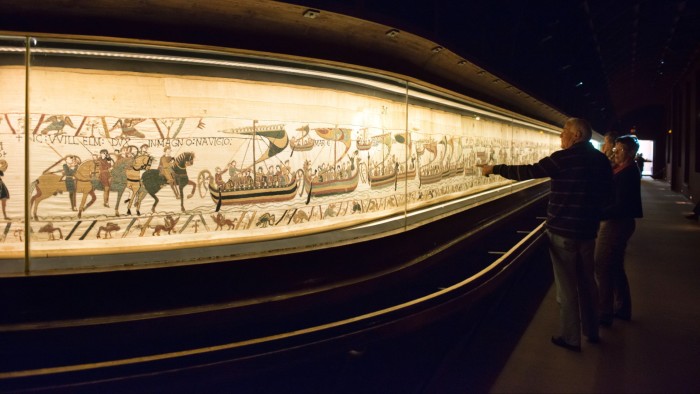Unlock the Editor’s Digest for free
Roula Khalaf, Editor of the FT, selects her favourite stories in this weekly newsletter.
When the Bayeux Tapestry comes to London next year, the British Museum will no doubt be showing it in near-darkness, a light level appropriate for the 900-year-old embroidery. The Victoria and Albert Museum, however, which thought it would be hosting the cloth until the surprise announcement this week, has been totally in the dark.
The world of museums is not known as particularly cut-throat. While they compete for donors and gifts, they recognise the fragility of their ecosystem, particularly when reliant on state subsidies, and tend to co-operate with the mission of the public good in mind. Exhibitions tour institutions across continents, individual paintings rack up air miles on loan.
But the triumph of the BM, chaired by former Tory chancellor George Osborne, shows that when a star piece is at stake, with concomitant ticket revenue, trinket sales and cream teas in the café, ruthlessness rules.
An inescapable tension is that the global field is not level. The J Paul Getty Trust, which runs the Getty museums in Los Angeles, had an endowment of $8.6bn in 2023; when London’s Tate launched its endowment drive last month its target was to raise a modest £150mn by 2030. A senior figure in UK museums points out that it is not just US museums but those in the Middle East, backed by the seemingly limitless wealth of royal families, that they have to compete against too.
UK museums have one reliable arrow in their quiver when it looks as if an outstanding cultural object might be taken abroad. If a standing committee of experts deems the work a national treasure, judging by history, aesthetics and scholarship, it will give British institutions the chance to raise the money, at market value, to keep it.
Works “saved for the nation” (as heralded) include an 18th-century painting by Bernardo Bellotto, Jane Austen’s ring and a large anthropomorphic crab from 1880 by Robert Wallace Martin. In 2024, the V&A (endowment: £760,000) had a success when it saw off an attempt by the Metropolitan Museum in New York (endowment: $4.5bn) to buy a 12th-century walrus ivory carving. But it took a sustained campaign to raise the £2mn.
Plenty more objects find themselves on an aircraft when the fundraising fails. A golden tiger’s head ornament from the throne of an Indian royal, set with rubies, diamonds and emeralds, overcame its export bar and went to Qatar in 2022. (Whether this object taken by British soldiers after killing the sultan should be considered a UK “national treasure” is another question.)
Sometimes hostility is outright, part of a broader political conflict. When Chinese nationalists fled Beijing and the Red army in 1949, they took more than 600,000 objects from the Forbidden City to Taiwan, where they remain today, including the finest ceramics I have ever seen. In 2023, Beijing made a pointed demand for their return and Taipei’s National Palace Museum faced cyber attacks.
More often, though, harmony reigns. In 2023, the National Portrait Gallery in London agreed a partnership with the vastly wealthier Getty Museum in LA to jointly purchase Sir Joshua Reynolds’ “Portrait of Mai”, splitting the £50mn price between them and alternating display. The Rijksmuseum in Amsterdam and the Louvre in Paris share a pair of Rembrandt portraits.
Tristram Hunt, director of the V&A, told me that the sector was “incredibly collegiate — we’re always lending and borrowing and things are going wrong at the last minute so people help each other out”. The Bayeux loan, he said graciously, would be excellent for the BM.
There are many threats to museums today: parsimonious governments, culture warriors, donors who want something in return, attention spans dwindling to the length of an Instagram story. The one thing they should be able to rely on is each other.
